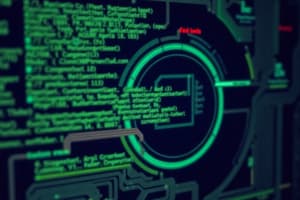Podcast
Questions and Answers
What is one of the key functions of an operating system?
What is one of the key functions of an operating system?
- Creating hardware components
- Making a computer more convenient to use (correct)
- Providing entertainment
- Performing mathematical calculations
What role does an operating system serve in a computer system?
What role does an operating system serve in a computer system?
- It only controls hardware.
- It is solely responsible for programming applications.
- It supports data storage only.
- It manages resources and provides an interface between users and hardware. (correct)
The primary role of an operating system is to control network traffic.
The primary role of an operating system is to control network traffic.
False (B)
An operating system is classified as a type of application software.
An operating system is classified as a type of application software.
What does an operating system do in terms of resource allocation?
What does an operating system do in terms of resource allocation?
What must be well defined before the design of a new operating system begins?
What must be well defined before the design of a new operating system begins?
The __________ system type allows only one user to access the system at a time.
The __________ system type allows only one user to access the system at a time.
Which generation of operating systems used punched cards as input?
Which generation of operating systems used punched cards as input?
The operating system manages communication among the different components of the computer system, the different application programs residing in memory, and the _____ of the computer system.
The operating system manages communication among the different components of the computer system, the different application programs residing in memory, and the _____ of the computer system.
Match the following operating system generations with their descriptions:
Match the following operating system generations with their descriptions:
Match the following characteristics with their respective types of software:
Match the following characteristics with their respective types of software:
Which of the following statements is true regarding the design of operating systems?
Which of the following statements is true regarding the design of operating systems?
An operating system can evolve without interrupting the existing services.
An operating system can evolve without interrupting the existing services.
What role does an operating system play as a traffic officer?
What role does an operating system play as a traffic officer?
Operating systems are designed to be convenient and efficient.
Operating systems are designed to be convenient and efficient.
What are the two main categories of software in a computer system?
What are the two main categories of software in a computer system?
Which operating system is an example of a multiuser operating system?
Which operating system is an example of a multiuser operating system?
Cooperative multitasking gives control back to the operating system at all times.
Cooperative multitasking gives control back to the operating system at all times.
What type of operating system is designed primarily for personal computers?
What type of operating system is designed primarily for personal computers?
The main goal of a __________ operating system is user-friendliness rather than resource optimization.
The main goal of a __________ operating system is user-friendliness rather than resource optimization.
Match the following operating system types with their descriptions:
Match the following operating system types with their descriptions:
Which of the following operating systems utilizes preemptive multitasking?
Which of the following operating systems utilizes preemptive multitasking?
Time sharing operating systems provide immediate feedback to users with response times in minutes or seconds.
Time sharing operating systems provide immediate feedback to users with response times in minutes or seconds.
Which type of operating system is characterized by allowing each user to directly interact via keyboard commands?
Which type of operating system is characterized by allowing each user to directly interact via keyboard commands?
Which of the following is an example of a real-time operating system?
Which of the following is an example of a real-time operating system?
A Hard Real-Time OS allows some flexibility in responding to task completion times.
A Hard Real-Time OS allows some flexibility in responding to task completion times.
What type of operating system is designed for dedicated functions within equipment?
What type of operating system is designed for dedicated functions within equipment?
An operating system that enables communication between computers over a network is known as a ________ Operating System.
An operating system that enables communication between computers over a network is known as a ________ Operating System.
Match the following operating systems with their types:
Match the following operating systems with their types:
Which of the following statements is true about Soft Real-Time Operating Systems?
Which of the following statements is true about Soft Real-Time Operating Systems?
Linux is an example of an embedded operating system.
Linux is an example of an embedded operating system.
Name one example of an operating system used in real-time applications.
Name one example of an operating system used in real-time applications.
What is the primary function of a file manager?
What is the primary function of a file manager?
Interrupts require the processor to constantly check on devices for requests.
Interrupts require the processor to constantly check on devices for requests.
What does the security manager guarantee regarding data?
What does the security manager guarantee regarding data?
In polling, the processor must ask each device connected if it needs to be __________.
In polling, the processor must ask each device connected if it needs to be __________.
Match the following components with their descriptions:
Match the following components with their descriptions:
What does the tracking mechanism provided by the security manager track?
What does the tracking mechanism provided by the security manager track?
A hardware interrupt is different from a software interrupt.
A hardware interrupt is different from a software interrupt.
What happens when an interrupt is received by the processor?
What happens when an interrupt is received by the processor?
Flashcards are hidden until you start studying
Study Notes
Operating System Overview
- A computer system is composed of hardware, software, and users.
- Software is categorized as system software or application software.
- System software manages and controls hardware, while application software facilitates user tasks.
- Hardware provides mechanisms to ensure proper system operation and prevent user program interference.
- Operating system design is a complex task requiring well-defined goals.
- Goals guide algorithm and strategy choices.
- Operating systems must be built in pieces with defined inputs, outputs, and functions.
- Operating systems for handheld computers aim for user-friendly interfaces.
- Operating systems can be designed for convenience, efficiency, or a combination of both.
What Is An Operating System?
- An operating system manages all computer system resources.
- It is a software component responsible for managing and coordinating computer activities and resource sharing.
- It acts as an intermediary between the user and computer hardware, managing communication between components, applications, and the user.
- Key tasks include:
- Continuously monitoring resources.
- Enforcing policies to determine resource allocation.
- Allocating resources.
- De-allocating resources.
- Directing data flow through the CPU, guiding memory access, data storage, and display.
- Monitoring user logins, resource usage, and access requests (acting as an accountant).
Functions of an Operating System
- Makes a computer system more convenient to use.
- Enables efficient use of computer system resources.
- Allows the development, testing, and implementation of new system functions without interrupting service.
Evolution of Operating Systems
- 1st Generation (1945-1955): Programmers directly operated the machine.
- 2nd Generation (1955-1965): Batch Operating System.
- Used punched cards or paper tapes as input.
- Jobs were processed sequentially without user interaction.
- Efficiency was measured by throughput and turnaround time.
- Second Generation Continued: Single User Operating System.
- Controlled by one user at a time.
- Examples: DOS, Palm OS, Windows CE, Inferno, Newton OS, Internet Tablet OS.
- 3rd Generation (1965-1985): Multiuser Operating System.
- Allowed a single computer (often mainframe) to handle simultaneous input, output, and processing requests from multiple users.
- Prioritized processing requests.
- Examples: Linux, Unix, Windows 2000, Windows XP.
- 3rd Generation Continued: Multi-programming Operating System (also called Multi-tasking).
- Enabled multiple software processes to run simultaneously.
- Could be either cooperative or preemptive:
- Cooperative multitasking hands control over to a program and waits for it to return control.
- Preemptive multitasking maintains OS control and manages program execution.
- Examples: Unix, Windows NT, Mac OS, Windows 95, Windows 9X.
- 3rd Generation Continued: Time Sharing Operating System (also called Interactive Systems).
- Provided direct user interaction via keyboard commands.
- Delivered computer services directly to the user through a terminal.
- Posed security and access control challenges.
- Provided immediate feedback with response times measured in minutes or seconds.
- 3rd Generation Continued: Personal Computer Operating System.
- Used for personal computers supporting a single user environment.
- Simpler than mainframe operating systems.
- Prioritized user-friendliness.
- Examples: Linux, Macintosh, MS-DOS, Windows 2000.
- 4th Generation (1985-Present): Real Time Operating System (RTOS).
- Uses time as a key parameter for operation.
- Considered multi-tasking, intended for real-time applications (e.g., programmable thermostat, appliance controllers, mobile phones).
- Can be Hard Real-Time (strict time requirements) or Soft Real-Time (more flexible response time).
- Examples: JavaFx Mobile, BeRTOS, INtime RTOS for Windows, iRMX, OS-9.
- 4th Generation Continued: Embedded Operating System.
- Implanted within equipment to control its operation.
- Performs dedicated functions.
- Examples: BlackBerry OS, embedded Linux, iPhone OS.
- 4th Generation Continued: Network Operating System (NOS) (also called Server Operating Systems, Distributed Operating System, or Loosely Coupled System).
- Enables computers to communicate through network cable or wireless transmission.
- Focuses on managing network resources.
File Manager
- Enables users and applications to work with files.
- Provides services related to:
- Creating, deleting, reading, and modifying files.
- Moving data between files.
- Backing up and recovering files.
- Rapidly accessing files.
- Ensuring file integrity and security.
Security Manager
- Protects data and resources from unauthorized access.
- Guarantees data and message authenticity.
- Defends systems against network attacks.
- Prevents users from accidentally or intentionally interfering with each other.
- Enforces security policies.
- Tracks resource access requests.
System Calls & Interrupts
- Processes inside a computer system communicate with the processor via system calls.
- The processor handles these communications using methods like polling and interrupts.
- Polling: The processor checks each connected device for requests.
- Interrupts: Devices signal the processor when they need attention, interrupting the processor's current task.
- Hardware and software interrupts can occur, prompting the processor to pause its current task to handle the request.
- Processor remembers the interrupted process's state to resume operation later.
- If multiple interrupts occur, they are handled based on priority.
Studying That Suits You
Use AI to generate personalized quizzes and flashcards to suit your learning preferences.



